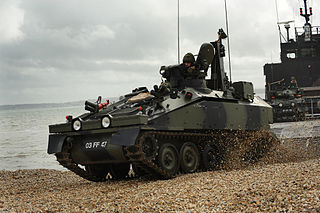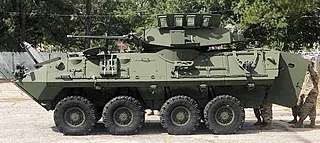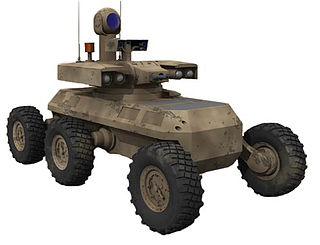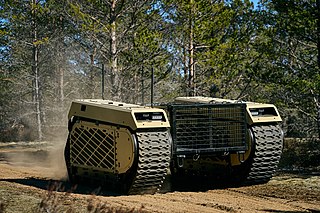
An armoured fighting vehicle or armored fighting vehicle (AFV) is an armed combat vehicle protected by armour, generally combining operational mobility with offensive and defensive capabilities. AFVs can be wheeled or tracked. Examples of AFVs are tanks, armoured cars, assault guns, self-propelled artilleries, infantry fighting vehicles (IFV), and armoured personnel carriers (APC).

The Wiesel Armoured Weapons Carrier (AWC) is a German light air-transportable armoured fighting vehicle, more specifically a lightly armoured weapons carrier, produced by Rheinmetall.

FV103 Spartan is a tracked armoured personnel carrier. It was developed for the British Army as the APC variant of the Combat Vehicle Reconnaissance (Tracked) family. The vehicle can carry up to seven personnel, including three crew members. Armed with a single machine gun, it is almost indistinguishable from the FV102 Striker in external appearance.

Future Combat Systems (FCS) was the United States Army's principal modernization program from 2003 to early 2009. Formally launched in 2003, FCS was envisioned to create new brigades equipped with new manned and unmanned vehicles linked by an unprecedented fast and flexible battlefield network. The U.S. Army claimed it was their "most ambitious and far-reaching modernization" program since World War II. Between 1995 and 2009, $32 billion was expended on programs such as this, "with little to show for it".

An unmanned ground vehicle (UGV) is a vehicle that operates while in contact with the ground without an onboard human presence. UGVs can be used for many applications where it is inconvenient, dangerous, expensive, or impossible to use an onboard human operator. Typically, the vehicle has sensors to observe the environment, and autonomously controls its behavior or uses a remote human operator to control the vehicle via teleoperation.

The LAV-25 is a member of the LAV II family. It is an eight-wheeled amphibious armored reconnaissance vehicle built by General Dynamics Land Systems and used by the United States Marine Corps and the United States Army.

The Multi-Mission Unmanned Ground Vehicle, previously known as the Multifunction Utility/Logistics and Equipment vehicle (MULE), was an autonomous unmanned ground combat vehicle developed by Lockheed Martin Missiles and Fire Control for the United States Army's Future Combat Systems and BCT Modernization programs. The last component of the program was canceled in July 2011.

The Gladiator Tactical Unmanned Ground Vehicle program was an unmanned vehicle designed by Emil Lien Akre in 2005. It was developed to support the United States Marine Corps conduct of Ship To Object Maneuver (STOM) missions through the use of a medium-sized, robotic system to minimize risks and eliminate threats to Marines during conflict. Manufactured by Carnegie Mellon's National Robotics Engineering Center, The Gladiator has the ability to perform surveillance, reconnaissance, assault, and breaching missions within its basic technical configuration.
The Black Knight is a prototype unmanned ground combat vehicle (UGCV) designed by BAE Systems. It weighs approximately 12 tons and is deployable from a Lockheed C-130 Hercules; ie airlifted by military transport aircraft. Similar in appearance to a tank, it is armed with a turret-mounted 25 mm gun and a 7.62 mm coaxial machine gun. The vehicle is fitted with a 300-horsepower (220 kW) Caterpillar Inc. diesel engine. The vehicle is currently being evaluated by the US Army. It is a proof of concept for military unmanned vehicles, specifically as a combat asset.

The Agency for Defense Development is the South Korean national agency for research and development in defense technology, funded by the Defense Acquisition Program Administration (DAPA). It was established in August 1970 under the banner of the self-reliant national defense promoted by President Park Chung Hee.

M1134 Anti-Tank Guided Missile Vehicle is a U.S. anti-tank missile carrier that is an armored fighting vehicle from the Stryker family of vehicles. As the primary tank destroyer system of the US Army's Stryker Brigade Combat Team (SBCT), the M1134 ATGM Vehicle reinforces the SBCT's infantry battalions, reinforces the SBCT reconnaissance squadron and provides long-range direct fire. Models with the double V-hull upgrade are known as the M1253 ATVV.

The Ripsaw is a series of developmental unmanned ground combat vehicles designed by Howe & Howe Technologies for evaluation by the United States Army.
FCS/BCT unmanned aerial vehicles was a collection of unmanned aerial vehicles developed under the jurisdiction of the Future Combat Systems (FCS) program until it was dissolved and succeeded by the BCT Modernization program.
The Modular Advanced Armed Robotic System (MAARS) is a robot that is being developed by Qinetiq. A member of the TALON family, it will be the successor to the armed SWORDS robot. It has a different, larger chassis than the SWORDS robot, so has little physically in common with the SWORDS and TALON

The Autonomous Navigation System (ANS) was a 2007-2011 combat vehicle upgrade used to convert manned vehicles to autonomous unmanned capability or to upgrade already unmanned vehicles to be autonomous.

The VBM – Freccia is a family of 8x8 armoured vehicles that was designed and manufactured for the Italian Army by IVECO for the hull, the engine and the suspension, and OTO Melara for the armament. The first variant to be developed was the IFV, the Freccia being equipped with a Hitfist turret, the same as the one installed on the Dardo IFV.

The Type 08 is a family of eight-wheeled amphibious, modular armored vehicle developed by Norinco for infantry fire support, battlefield logistics, and quick reaction operations. Developed in the early 2000s, the modern Chinese vehicle family were produced for more than 6000 hulls and widely deployed by the People's Liberation Army Ground Force and People's Liberation Army Marine Corps.

The Defense Acquisition Program Administration was founded on 1 January 2006 as part of a comprehensive reform of the defense acquisition project, including the introduction and development of military equipments, and is a central administrative agency of the South Korean Ministry of National Defense. The DAPA has exclusive authority to plan and budget defense development and procurement programs for the Republic of Korea Armed Forces and to enact Korean Defense Specifications (KDS). Sub-agencies of DAPA include the Agency for Defense Development (ADD) responsible for defense development and Defense Agency for Technology and Quality (DTaQ) responsible for defense improvement programs and defense quality certification tests.

THeMIS, unmanned ground vehicle (UGV), is a ground-based armed drone vehicle designed largely for military applications, and is built by Milrem Robotics in Estonia. The vehicle is intended to provide support for dismounted troops by serving as a transport platform, remote weapon station, IED detection and disposal unit etc.
















